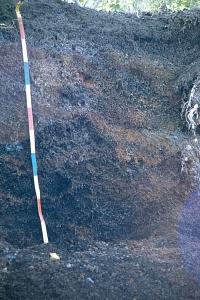Reference soil China 42: Leptosol
Leptosols are by far the most extensive group of soils in the world. They are found mainly in mountainous regions and in areas where soil has been eroded to the extent that hard rock comes near to the surface. Other (minor) occurrences are along rivers where gravely deposits have accumulated without substantial admixture of fine earth material.
Characteristics
Soils which are either limited in depth by continuous hard rock within 25 cm from the soil surface, or overly mayerial with a calcium carbonate equivalent of more than 40 percent within 25 cm from the soil surface, or contain less than 10 percent (by weight) fine earth (mineral soil material with a diameter of 2 mm or less) to a depth of 75 cm from the soil surface. Leptosols have no diagnostic horizons other than a mollic, ochric, umbric, vertic or yermic horizon.
Reference soil CN042: Leptosols
PROFILE DESCRIPTION : Deep, excessively drained, brown to black gravel derived from 270 year old volcanic ejecta. The volcanic soil material has been only slightly altered. The soil has a medium content in organic carbon and a neutral soil reaction throughout. GENERAL LANDFORM: The Heilungshan volcano erupted 1719-21, the years 58 - 60 of the reign of Qin emperor Kangsi. At the same time the Hoshoushan volcano, some 5 km NE, was active. The Heilungshan volcano is situated on a rather small basalt plateau (estimated 50 sqkm) of the same age SURFACE DRAINAGE: The disturbance of the drainage pattern by the basalt flow is reflected in the name Wu da lian chi: five-large-interconnected-lakes, which refers to the lava-forced moving of the river to the east and creating a number of natural reservoirs PARENT MATERIAL: the actual basalt plateau is situated on a larger basalt plateau (some 1600 sq km in the geological map), consisting of three known sheets dating from 1.3, 0.8-0.9 and 0.3-0.65 my ago (K Ar dating). According to its composition it is of a rather rare type, having a relatively high K and Si content and a relatively low Ca content. These older basalts are covered by loess(like) deposits. Apart from the lavaflow ash was deposited. These ashes are rather coarse and are mainly found on the lava field. The loess-like deposits bordering the volcano have only been contaminated with (finer) ash materials in the upper cm or less. This mixed layer may be the result of plowing since plowing to about 18 cm is combined with ridge and furrow cultivation of some 15 cm height / CLIMATE: additional climatic data are available for the weather stations of Keshan (48 3 N/125 52 E; 237 m a.s.l.; 77 km SW of site; relevance: poor to moderate) and Nenjiang (49 10 N/125 14 E; 242 m a.s.l.; 83 km NW of site; relevance; poor to moderate).
